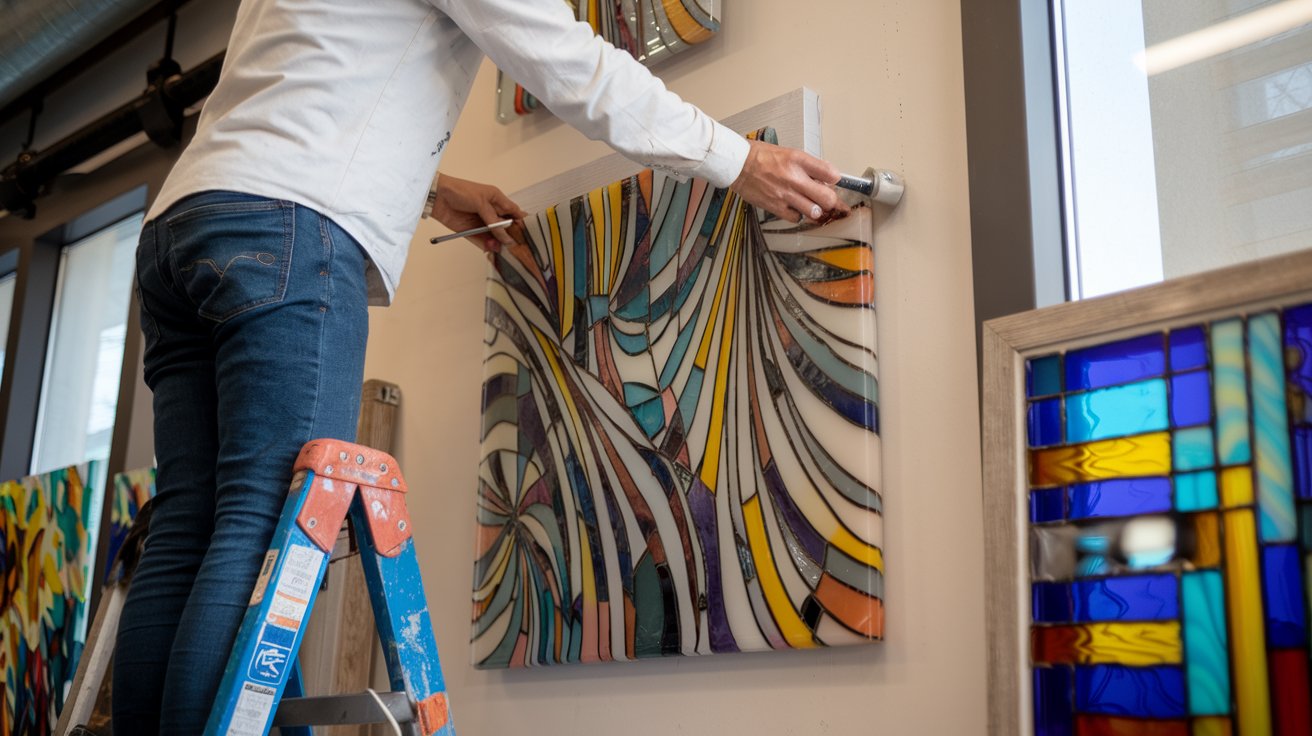The allure of fused glass wall art in any room is undeniable. A variety of colors, shapes, and brightness can transform the feel of your space. These art pieces, made with careful layering and melting methods, merit a display that not only amplifies their allure but also promises durability.
Hanging your art right is very important. It keeps your delicate glass art safe, stops accidents, and shows off the artwork. In this guide, we teach you all about hanging fused glass wall art. We’ll cover the best place, tools, and offer step-by-step guidance. Let’s dive in!
Why A Proper Installation Should Be Made
A piece of fused glass art is different from your usual painting or framed picture. It needs special care when putting it up.
- Weight: Fused glass can be surprisingly heavy, so it needs strong support. If not hung correctly, it could damage the artwork and wall.
- Delicacy: Glass is fragile. Even a little mishandling or wrong hanging techniques can cause chips, cracks, or even total breakage.
- Unique Mounting Needs: Fused glass isn’t like the usual framed prints or canvas pieces; its surface might be uneven or backings might be different. You have to pick the right tools to hang it.
- Aesthetic Impact: Where you place the artwork matters. If a piece is tilted or not aligned right, it doesn’t show off its beauty, especially when light falls on its surface and textures. A misplaced piece might mess up the feel of the room.
- Safety Concerns: If a heavy or badly hung up glass art falls, it’s a safety risk. So, putting it up securely is not only about aesthetics but also safety.
Preparing for Installation
When you hang your beautiful piece of fused glass artwork, there are a few things to keep in mind. Here’s what you need to think about:
- Light: Your artwork will look its best in places with good light. Both natural and fake light are great. Try to place it where the light can shine through it, like next to a window. This will make the colors and the design really stand out.
- Wall Material: Is your wall made of drywall, plaster, or concrete? Maybe something else? This is important because it helps you figure out what kind of hardware you’ll need.
- Room Decor: You want your artwork to add to the room, not take away from it. Choose a place where it fits in with the other stuff in the room.
- Humidity and Temperature: Keep the artwork away from very humid spots like the bathroom. Also, avoid direct sunlight. Too much of either can damage the art, including fading the colors.
Tools and Materials You Will Need
Having the right tools on hand will make the process smoother. Here’s what you’ll need:
Tools:
- Drill with appropriate bits
- Stud finder
- Measuring tape
- Level
- Pencil or chalk for marking
Hanging Hardware:
- Sturdy wall anchors for heavier pieces
- D-rings or brackets if not pre-installed
- Adhesive hooks (for smaller, lightweight pieces)
Protective Gear:
- Gloves to handle the glass safely
Inspecting the Fused Glass Wall Art
Have a look at the back of your fused glass artwork before beginning. Plenty of these artworks come with hanging devices like metal loops or brackets already in place. If it’s missing, you’ll need to mount proper hardware. It’s vital to verify the artwork’s weight and size to make sure your selected hardware can hold it up safely.
Step-by-Step Guide to Hanging Fused Glass Wall Art
Step 1: Marking the Spot
Start by choosing a position for your fused glass wall art based on it’s size:
- Measure the height at which you want the artwork to hang. A common rule is to position the center of the piece at eye level, typically around 57-60 inches from the floor.
- Use a measuring tape and level to mark the desired spot on the wall. For multiple pieces, plan the layout beforehand to maintain balance and symmetry.
Step 2: Choosing the Right Hanging Hardware
Choosing the right hanging hardware of your art is based on it’s weight this is also compatible for all art types such as metal wall art :
- D-rings and Wall Anchors: Ideal for heavy pieces. Install wall anchors first to ensure the screws stay firmly in place.
- Adhesive Hooks: Suitable for lightweight art and smooth wall surfaces. Ensure the adhesive is rated to hold the weight of your piece.
- Wire Systems: If the artwork has a hanging wire, use hooks that can securely hold the wire in place.
How to Install:
- Drill a pilot hole if using screws or anchors.
- Insert the hardware and tighten it securely. Double-check that it is level.
Step 3: Mounting The Fused Glass Wall Art
Now that the hardware is set, let’s hang the artwork correctly:
- Gently raise the fused glass art, using gloves for protection, and line it up with the hardware you’ve installed. This safeguards both the art and your hands.
- Get the artwork fixed on the hooks or brackets. If you’re using a wire system, make sure it’s tight and balanced.
- Take a step back and examine the alignment. Make any needed adjustments.
Step 4: Final Adjustments
Once the piece is mounted, make these final checks:
- Ensure the artwork is level using a bubble level.
- Gently clean the surface of the glass with a microfiber cloth to remove fingerprints.
- Inspect the hardware periodically to ensure it remains secure over time.
Additional Tips and Tricks
Creating a Gallery Wall
if you got multiple fused glass pieces You can boost your room’s look by organizing them in a gallery-style. Use different sizes and shapes for an appealing and lively show. Keep them 2-3 inches apart for neatness. Before putting them on the wall, lay out your plan on the ground. This way, you can try various setups to hit on the best one. Perhaps pick a theme or color pattern to link the exhibit together. This won’t just lift the total look but also pair the standalone pieces perfectly.
Protecting Walls and Art
Caring for your art and walls keeps them looking great. You can use felt pads or spacers on the back of your art to avoid wall damage. For big pieces, spacers add balance and let air flow behind the glass. This helps keep your walls from getting damp and changing color. Also, dust your art and the wall around it often. This easy habit can keep your display clean and your collection beautiful for years to come.

